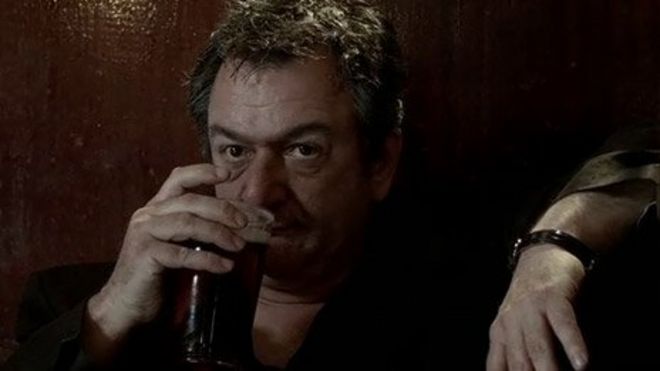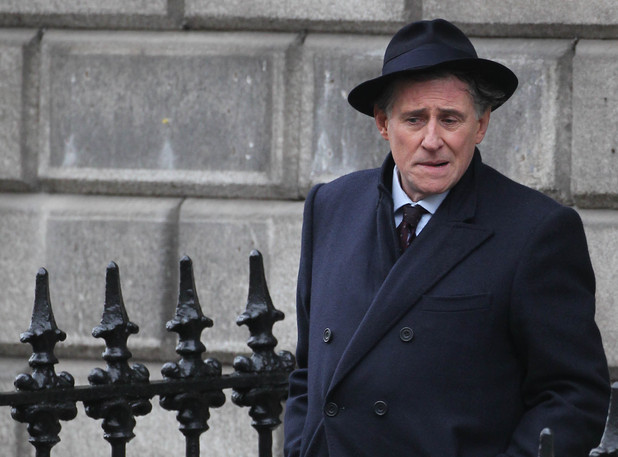Discuss the ways the extract constructs representations of regional identity.
Consider:
Consider:
- Camera work/angles/movement
- Sound
- Editing
- Mise-en-scene
The scene opens with an establishing shot, showing two working class men and Doc Martin in the same room. The camera angle shows Doc Martin at the centre of the shot and shows him from a low angle standing above the two sitting labourers. This camera angle represents his superiority over the others, which indicates perhaps the differences in where they originate from- someone from a more formal, wealthy background could be shown as more superior which is the case here. Another indication of their differences in regional identity is their clothing, DM wears a suit whereas the two men wear overalls and appear rather scruffy and dirty. This indicates their from different regions in the UK as in rural areas the stereotype is are farmers or manual jobs which require a lot of outdoor work or with things such as paint which can make a mess whereas more urban areas the stereotype is office jobs in a comfortable working environment sheltered from the outside world. The viewer is provided with an action code, we can see the sink which emphasises what the workers are doing. The younger of the two- assumed to be the son of the other, appears to go against the stereotype (counter type) and could be shown as being ‘trapped’ in the ways of his family or home town, this is shown by his dialogue throughout the first scene. The music at the end of the scene helps to establish a sense of the pace of the accompanying scene. It is used to represent the dominance of DM over the dog- this accompanied with the high angled shot showing DM looking down on the dog is used as a sound bridge to carry over the same representation to the following scene. This shows DM isn’t fond or familiar with dogs this may show where he is from people are less friendly with animals/dogs and tend to be more popular or common in rural areas.
In the next setting where DM is walking the dog, a long shot and a tracking shot is used. This allows the audience to compare clothing of DM compared to rest of village, each outfit portrays the regions each person represents. He then goes into a police station where DM shows commanding nature via body language and dialogue when speaking to policeman, this represents different ways and background. It should be the police man with the authoritative position this may indicate that he feels he is in a superior position. From this scene we can infer that people from a more wealthy, posh, upper class background are portrayed as more in control, commanding position whereas people from more rural areas are stereotyped as being 'backwards'. We then meet a character who is a countertype of the rural area stereotype, the audience senses similarities between herself and DM, she appears upper class, dressed more upper class and comes across posh with a similar accent too. She is also represented as upper class in comparison to the rest of the community, at this point the camera is at a mid shot with a similar angle when both are speaking- this could show they are both in an equal position.
When the audience is shown the woman with the eye patch and DM looking at each other, we sense affection between the two, this represents equality and respect between them which is something which has lacked between him and the rest of the village the entire extract. This scene counters the rest of the extract as before this we always saw DM as more superior and came across as more 'important' because of his upper class nature and job role. He is then interrupted and called over by an older woman to help her moving around boxes of fruit and vegetables this is an action code used to represent the kind of jobs (as well as the sink) that are done around the village, whereas in comparison to DM's job, a doctor, appear rather insignificant to his role in society.
In conclusion, the extract portrays a clear divide between the community and of people from different backgrounds. It portrays the classic stereotypes of a rural community and how DM doesn't really fit into their society but has a more significant role in their society than many others so is considered more important or superior to rest. However, we do certain characters go against the stereotype, for example the younger of the two men working on the sink or the woman asking about a prescription as they come across more intelligent and don't fit into the rural community as well as DM.
In the next setting where DM is walking the dog, a long shot and a tracking shot is used. This allows the audience to compare clothing of DM compared to rest of village, each outfit portrays the regions each person represents. He then goes into a police station where DM shows commanding nature via body language and dialogue when speaking to policeman, this represents different ways and background. It should be the police man with the authoritative position this may indicate that he feels he is in a superior position. From this scene we can infer that people from a more wealthy, posh, upper class background are portrayed as more in control, commanding position whereas people from more rural areas are stereotyped as being 'backwards'. We then meet a character who is a countertype of the rural area stereotype, the audience senses similarities between herself and DM, she appears upper class, dressed more upper class and comes across posh with a similar accent too. She is also represented as upper class in comparison to the rest of the community, at this point the camera is at a mid shot with a similar angle when both are speaking- this could show they are both in an equal position.
When the audience is shown the woman with the eye patch and DM looking at each other, we sense affection between the two, this represents equality and respect between them which is something which has lacked between him and the rest of the village the entire extract. This scene counters the rest of the extract as before this we always saw DM as more superior and came across as more 'important' because of his upper class nature and job role. He is then interrupted and called over by an older woman to help her moving around boxes of fruit and vegetables this is an action code used to represent the kind of jobs (as well as the sink) that are done around the village, whereas in comparison to DM's job, a doctor, appear rather insignificant to his role in society.
In conclusion, the extract portrays a clear divide between the community and of people from different backgrounds. It portrays the classic stereotypes of a rural community and how DM doesn't really fit into their society but has a more significant role in their society than many others so is considered more important or superior to rest. However, we do certain characters go against the stereotype, for example the younger of the two men working on the sink or the woman asking about a prescription as they come across more intelligent and don't fit into the rural community as well as DM.


